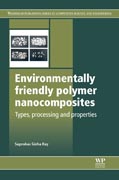
Environmentally Friendly Polymer Nanocomposites: Types, Processing and Properties
Raya , Jose Luis
Concerns about global warming and the depletion of oil reserves have led to significant research into more sustainable composite materials made from natural materials. Recently, research has focussed on the development of nanoscale reinforcements for this new group of composites, significantly improving and extending their range of desirable properties. Environmentally friendly polymer nanocomposites summarises this wealth of research and its practical implications.After an introduction to the subject, part one looks at matrix and reinforcement materials as well as their characterisation. Part two reviews key properties such as tensile and dynamic mechanical properties and thermal stability. It also considers issues such as barrier properties, biodegradability, rheology, electrical and thermal conductivity. The book concludes by reviewing potential applications.This book is ideal for polymer and material scientists, researchers and engineers. It will also help industrial researchers and R&D managers who want to bring advanced eco-friendly polymer composite-based products into the market. Summarises the practical implications of the development of nanoscale reinforcements for sustainable composite materials made from natural materialsExamines matrix and reinforcement materials and their characterisation and reviews key properties such as tensile and dynamic mechanical propertiesConsiders barrier properties, biodegradability, rheology, electrical and thermal conductivity and potential applications INDICE: Part 1 Types, processing and characterisation: Introduction to environmentally friendly polymer nanocomposites; Environmentally friendly polymer matrices for composites; Environmentally friendly nanofillers as reinforcements for composites; Techniques for characterising the structure and properties of polymer nanocomposites; Environmentally friendly polymer nanocomposites using polymer matrices from renewable sources; Environmentally friendly polymer nanocomposites using polymer matrices from fossil fuel sources; Processing of environmentally friendly polymer nanocomposite foams for packaging and other applications. Part 2 Properties: Using biodegradable polymer matrices and clay/carbon nanotube (CNT) reinforcements: Tensile properties of environmentally friendly polymer nanocomposites using biodegradable polymer matrices and clay/CNT reinforcements; Dynamic mechanical properties of environmentally friendly polymer nanocomposites using biodegradable polymer matrices and clay/CNT reinforcements; Thermal stability and flammability of environmentally friendly polymer nanocomposites using biodegradable polymer matrices and clay/CNT reinforcements; Barrier properties of environmentally friendly polymer nanocomposites using biodegradable polymer matrices and clay/CNT reinforcements; Crystallization behaviour, kinetics and morphology of environmentally friendly polymer nanocomposites using biodegradable polymer matrices and clay/CNT reinforcements; Biodegradation behavior of environmentally friendly polymer nanocomposites using biodegradable polymer matrices and clay/CNT reinforcements; Rheological properties of environmentally friendly polymer nanocomposites (EFPNs) using biodegradable polymer matrices and clay/CNT reinforcements; Electrical and thermal conductivity of environmentally friendly polymer nanocomposites (EFPNs) using biodegradable polymer matrices and clay/CNT reinforcements. Part 3 Summary: Applications, environmental impact and future development of environmentally friendly polymer nanocomposites (EFPNs).
- ISBN: 978-0-85709-777-4
- Editorial: Woodhead Publishing
- Encuadernacion: Cartoné
- Páginas: 512
- Fecha Publicación: 31/07/2013
- Nº Volúmenes: 1
- Idioma: Inglés
